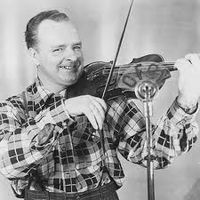Annotation:Little Judique Reel: Difference between revisions
No edit summary |
No edit summary |
||
| (2 intermediate revisions by 2 users not shown) | |||
| Line 1: | Line 1: | ||
---------- | |||
---- | {{TuneAnnotation | ||
|f_tune_annotation_title= https://tunearch.org/wiki/Annotation:Little_Judique_Reel > | |||
'''LITTLE JUDIQUE REEL.''' Canadian, New England; Reel. D Major ('A' part) & A Major ('B' part). Standard tuning (fiddle). ABB' (Miller & Perron): AABB' (Messer): AA'BB' (Songer). The tune comes from the playing of Canadian fiddler Don Messer [http://www.gov.ns.ca/nsarm/virtual/messer/default.asp] [http://en.wikipedia.org/wiki/Don_Messer] (1909-73), a professional fiddler, music director, music writer and entertainer. He formed his band in the 1920's, perfected his sound by the late 1930's, and continued with it virtually unchanged until the end of his career around 1970. From 1956 to 1969 he had his own show on Canadian television, hugely popular in its hey-day. | |f_annotation='''LITTLE JUDIQUE REEL.''' Canadian, New England; Reel. D Major ('A' part) & A Major ('B' part). Standard tuning (fiddle). ABB' (Miller & Perron): AABB' (Messer): AA'BB' (Songer). The tune comes from the playing of Canadian fiddler Don Messer [http://www.gov.ns.ca/nsarm/virtual/messer/default.asp] [http://en.wikipedia.org/wiki/Don_Messer] (1909-73), a professional fiddler, music director, music writer and entertainer. He formed his band in the 1920's, perfected his sound by the late 1930's, and continued with it virtually unchanged until the end of his career around 1970. From 1956 to 1969 he had his own show on Canadian television, hugely popular in its hey-day. | ||
[[File:messer.jpg|200px|thumb|left|Don Messer]] | [[File:messer.jpg|200px|thumb|left|Don Messer]] | ||
The melody is distinctively Canadian, and displays Quebecois influence in the melody, although the source for the tune (other than Messer) is unknown. | The melody is distinctively Canadian, and displays Quebecois influence in the melody, although the source for the tune (other than Messer) is unknown. See also a jig setting as "[[Queen's Marriage (The)]]." | ||
|f_source_for_notated_version=mandolin player Mark Bautista (Portland, Oregon) [Songer]. | |||
|f_printed_sources=Messer ('''Way Down East'''), 1948; No. 23. Messer ('''Anthology of Favorite Fiddle Tunes'''), 1980; No. 43, p. 31. Miller & Perron ('''New England Fiddlers Repertoire'''), 1983; No. 146. Songer ('''Portland Collection'''), 1997; p. 127. | |||
|f_recorded_sources=Apex AL1628, Don Messer - "More Down East Dancin'" (1963). F&W Records 2, "F&W String Band 2." Front Hall 010, Bill Spence & Fennigs All-Stars--"The Hammered Dulcimer Strikes Again." | |||
|f_see_also_listing=Jane Keefer's Folk Music Index: An Index to Recorded Sources [http://www.ibiblio.org/keefer/l07.htm#Litjure]<br> | |||
Jane Keefer's Folk Music Index: An Index to Recorded Sources [http://www.ibiblio.org/keefer/l07.htm#Litjure]<br> | |||
Alan Snyder's Cape Breton Fiddle Recordings Index [http://www.cbfiddle.com/rx/tune/t3664.html]<br> | Alan Snyder's Cape Breton Fiddle Recordings Index [http://www.cbfiddle.com/rx/tune/t3664.html]<br> | ||
}} | |||
Latest revision as of 18:01, 7 May 2023
X:1 T:Little Judique Reel M:C| L:1/8 R:Reel K:D a^g ab a2f2|d2A2A2fg|a^g ab a2f2|d6ef| gf ga g2e2|c2A2c2ef|gf ga g2e2|c4f3g| a^g ab a2f2|d2A2A2fg|a^g ab a2f2|d4g3a| b2gb a2fa|g2eg f2ed|c2Ac a2c2|d4c3d|| K:A |:e4e3f|e2c2B2A2|ag ab a2f2|e4f3g|a3ba2f2 | e2c2a2f2 |1 e2c2B2A2 | B4B2cd :|2 e2c2B2c2| A4f3=g |]
LITTLE JUDIQUE REEL. Canadian, New England; Reel. D Major ('A' part) & A Major ('B' part). Standard tuning (fiddle). ABB' (Miller & Perron): AABB' (Messer): AA'BB' (Songer). The tune comes from the playing of Canadian fiddler Don Messer [1] [2] (1909-73), a professional fiddler, music director, music writer and entertainer. He formed his band in the 1920's, perfected his sound by the late 1930's, and continued with it virtually unchanged until the end of his career around 1970. From 1956 to 1969 he had his own show on Canadian television, hugely popular in its hey-day.

The melody is distinctively Canadian, and displays Quebecois influence in the melody, although the source for the tune (other than Messer) is unknown. See also a jig setting as "Queen's Marriage (The)."

